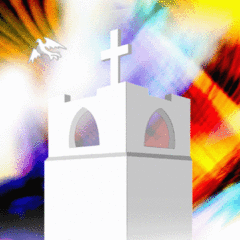The Three Days, also known as the Triduum in Latin, takes place at the climax of Holy Week, and it’s actually one worship service in three parts over three days: Maundy Thursday, Good Friday, and Saturday Easter Vigil.
First comes Triduum Part I (Maundy Thursday), and the word “Maundy” means mandate or commandment, referring to the Love Commandment of Jesus Christ our Lord. Consequently, Maundy Thursday centers on Jesus’ command for us to love one another as he loves us. It is also the night we commemorate the instituting of the Lord’s Supper. Then, at the end of this first part of the Triduum, the lights are dimmed and the altar is stripped bare while Psalm 22 is read, foreshadowing the commemoration of the crucifixion of our Lord on Good Friday.
Second comes Triduum Part II (Good Friday), and this day is the second part of the liturgy of The Three Days, extending from Maundy Thursday through Saturday Easter Vigil (Easter Eve). As the Church of Jesus Christ throughout the world gathers to remember the suffering and death of Jesus on this day, the altar is dressed in black, and we focus on the significance of the sacrificial love that Jesus showed us upon the cross of Calvary. In this way, Good Friday brings us to the foot of the cross, where Jesus bore our sins and died in our place. Here we stand before the cross, beholding the Lamb of God who takes away the sin of the world [see John 1:29].
Third comes Triduum Part III (Saturday Easter Vigil), and this is the night when Christians around the world gather to celebrate Christ’s passage from darkness to light, from death to life. The Easter Vigil service is the other candlelight service of the Church calendar. This special service includes powerful signs: a “new fire” burning in a fire pit outside the church, the Christ Candle lit from the new fire, our handheld candles lit from the Christ Candle, the Word of our Baptismal Covenant declared, and the very first Eucharistic Meal of Eastertime received. As the altar is changed from the darkness of Good Friday to the white and gold of heavenly light, we are the first to exclaim, “Alleluia! Christ is risen!”
For Lutherans, the Triduum is the very heart of the Christian year. Far from a mere historical remembrance, the Triduum invites us to encounter the Living Christ, and through faith, we are united in the awe and wonder of his victory. Maundy Thursday calls us to love and serve as Christ did, and to be strengthened and kept in true faith by his body broken and blood shed for us, received in bread and wine. Good Friday anchors us in the cross as the source of our atonement and reconciliation with God. And Saturday Easter Vigil proclaims the new light and life we possess, showered upon us in our Risen Lord Jesus Christ, which changes everything for us.
Again, Maundy Thursday calls you to love and to receive grace. Good Friday anchors you in Christ’s atoning sacrifice and forgiveness, even when your life seems to be falling apart. Saturday Easter Vigil steadies you to wait on God’s timing to bring light anew and life everlasting. So the Triduum isn’t just three holy days — it’s a way of life. We live as those who are set free. When guilt creeps in, remind yourself that your sins died with Jesus on the cross and stayed behind in the tomb when he rose again. When fear of death looms, cling to the promise of your own resurrection made possible by his. And always celebrate small victories, like a kind word or a mended relationship, as echoes of the big victory of the crucifixion and resurrection of Christ our Savior.
Blessed Triduum & Happy Easter!!! Pastor Tim
